
 |
|
|
|
|
After dinner, the men made a chart of the rock strata in the vicinity of Bath, identifying strata by color, hardness, and the fossils they held. In all, they named 23 layers, employing colorful names like Fuller’s Earth, Lias Blue, and Ditto White. Among these layers, the men noted something odd. Between strata they called Millstone and Pennant Stone was a dramatic change in the kinds of fossils found in the rocks. In the Millstone layer, plant fossils dominated. In the Pennant Stone layer, marine mollusk shells dominated. |
(William Smith portrait courtesy USGS/Abner Lowe.) | ||
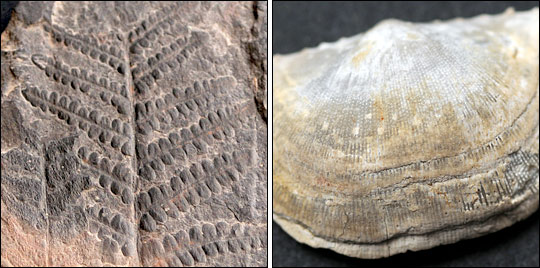 | |||
Today, geologists recognize this fossil turnover as the boundary between the Carboniferous Period (360 to 300 million years ago), when abundant swamps laid the foundation for many of today’s coal beds, and the Permian Period (300 to 250 million years ago), when Earth’s landmasses coalesced into a single continent. In 1799, however, when Smith and his friends noted the fossil shift, they didn’t grasp the hundreds of millions of years of changing landscapes that geologists recognize today. For Smith, the finding provided more evidence for his idea that rock layers across England occurred in a predictable pattern, and that wherever they occurred, they could be identified and connected to distant rock outcrops by the unique collections of fossils they held. He called this idea the principle of faunal succession, or fossil succession. |
William Smith noticed a curious turnover in fossils between two rock layers near Bath, England. The lower layer was rich in plants; the upper layer was rich in seashells. Fossil turnovers were later discovered in rocks of the same age all over the world. (These fossils are from the United States.) The turnover Smith noticed is now recognized as the boundary between the Carboniferous and Permian Periods. (Photographs ©2008 Dave Baysinger, Denver Museum of Nature & Science.) | ||
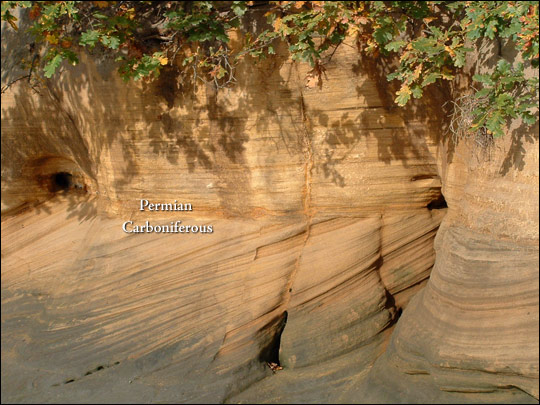 | |||
In the short term, the principle of faunal succession allowed Smith to place rock formations in the proper order throughout England, to identify lucrative coal seams for a fuel-hungry nation, and to publish a geologic map of England and Wales—the most detailed, accurate map then produced for such a large area. In the long run, it helped succeeding generations of scientists uncover the history of life on Earth. |
The boundary between the Permian Yellow Sands Formation (above), and the Carboniferous Pennine Upper Coal Measures (below) is exposed along the banks of the River Wear, roughly 500 kilometers north of Bath. (Photograph ©2003 George Plemper. Image interpretation by John H Powell, British Geological Survey.) | ||
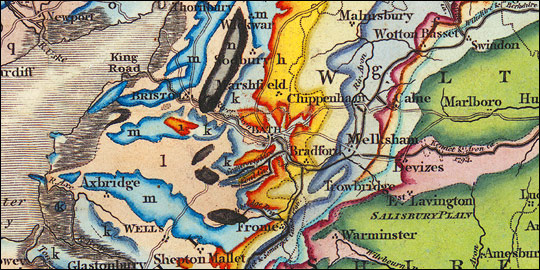 | |||
Changing Pictures of the PastWilliam Smith was born on March 23, 1769. When he was eight, his father died, and his mother sent him to live on an uncle’s farm. Smith’s own nephew would later recount how the boy’s new guardian “was little pleased with his nephew’s love of collecting ‘pundibs’ and ‘poundstones’” that littered the farm. The pundibs, which made excellent marbles for Smith and his boyhood friends, were really tiny, ancient brachiopods—marine invertebrates with a superficial resemblance to clams. The handy pound weights sometimes used to balance butter scales were actually fossil sea urchins—harder to recognize without their spiky armor. |
Smith’s 1820 map A New Geological Map of England and Wales illustrates the complex geology surrounding Bath, England (image center). (Reproduced by permission of the British Geological Survey. ©2008 NERC. All rights reserved. IPR/100-28DR. To obtain a copy of the map, visit the BGS online shop.) | ||
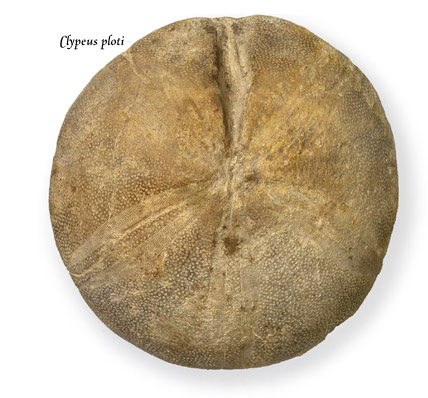 |
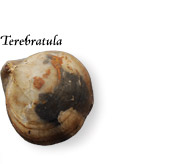 William Smith was intrigued with fossils at a young age. Family members recall that he collected the fossilized sea urchins (probably Clypeus ploti) that local milkmaids used to weigh butter, and Smith and his friends played marbles with fossil brachiopods (perhaps of the genus Terebratula.) [Photographs ©2004 Natural History Museum, London (Clypeus ploti) and ©2008 Dave Baysinger, Denver Museum of Nature & Science (Terebratula).] | ||
As a little boy, Smith likely didn’t grasp what these objects were, but some keen thinkers did. In the centuries before his birth, natural historians had debated what fossils might be—remains of once-living organisms or products of the planet’s alleged ability to grow plant and animal look-alikes in rock. By Smith’s time, geologists widely accepted that fossils were the remains of living things, the same conclusion reached by the seventeenth-century scholar and Danish anatomist Nicolaus Steno. Steno had also proposed several principles about rock formation that, by Smith’s time, most geologists embraced: older rocks generally lay below younger ones and layers of sedimentary rocks were originally laid down horizontally, even if geologic upheavals tilted them afterwards. By the early nineteenth century, respected geologists throughout Europe tacitly agreed—contrary to a literal interpretation of the Bible—that our planet possessed an unimaginably long pre-human history. |
|||
|
Subscribe to the Earth Observatory About the Earth Observatory Contact Us Privacy Policy and Important Notices Responsible NASA Official: Lorraine A. Remer Webmaster: Goran Halusa We're a part of the Science Mission Directorate |
|
|